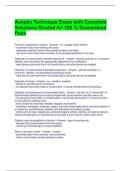Aseptic Technique Exam with Complete
Solutions Graded A+ 100 % Guaranteed
Pass
Purpose of protective eyewear - Answer-- ex.: goggle, facial shields
- to prevent fluids from entering the eyes
- especially important when blood splashes/spurts are likely
- use when other body fluids are likely to be sprayed/splashed on the face
Disposal of contaminated reusable equipment - Answer-- placed carefully in a container,
labeled, and returned to the appropriate department for sterilization
- wear gloves and wash/hand rub hands before and after gloves are applied
Disposal of contaminated disposable equipment - Answer-- placed carefully in a
container, labeled, and discarded according tp policy
- wear gloves and wash/hand rub hands before and after gloves are applied
Disposal of sharps - Answer-- ex.: needles, scalpels
- placed in puncture-proof containers
- no attempt should be made to recap, bend, or break needles before discarding
Disposal of miscellaneous contaminated items - Answer-- ear tips of a "community" or
departmental stethoscope should be wiped with alcohol before and after each use
- if a sphygmomanometer is contaminated, it should be disinfected in a manner similar
to that used for clothing items
- linen should be minimally handled, bagged, and labeled
- dressings, bandages, materials, paper, and other disposable items should be placed in
a nonporous container/bag, labeled, and discarded according to policy
- items such as toys, magazines, personal hygiene articles, dishes, and eating utensils
should be disposed of or disinfected and should not be used by others before then
Patients more susceptible to infection - Answer-- open burns/wounds
- disease that compromises immune system
- receiving chemotherapy or body irradiation
Why to use warm water - Answer-- comfort
- promotes lather that cleanses more effectively
- when rinsed, better carries pathogens away
,3 factors involved with use of Isolation Precautions - Answer-1. source of infecting
microorganisms (patients, employees, visitors)
2. susceptible host
3. means of transmission (contact, droplet, airborne)
5 primary transmission routes - Answer-1. contact (direct or indirect)
2. droplet (sneeze, cough, talking)
3. airborne (evaporated droplets, dust particles)
4. common vehicle (food, water, medicatioins)
5. vector-borne (mosquitoes, flies, rats, bats)
Diseases transmitted by droplet - Answer-- meningitis
- influenza
- streptococcal pharyngitis
- pneumonia
Asepsis - defined - Answer-absence of all microorganisms that produce disease;
prevention by maintaining a serile condition
Hand rubbing (product composition) - Answer-- 60-95% alcohol
- 1-3% skin conditioner
Purpose of hand washing - Answer-- remove or decrease number of pathogens on skin
(hands, wrists, forearms)
- caregivers can carry microorganisms from on pt. to another, causing infection in
second pt.
When to wash hands - Answer-- before and after patient care
- if treating wound, then wash, glove, and wash again after removing gloves (don't touch
nose, eyes, ears, or mouth after pt care and after toileting)
Isolation Precaution Guidelines - Answer-- usually on color-coded card posted outside
door to patient's room
- type of isolation should be noted on chart
- visitors directed to nurse's station
- cart outside patient room with necessary items
- containers for disposal of contaminated items should be in the patients room near the
door
Removal of PPC (personal protective clothing) - Answer-- NOT Protective Isolation
- don't touch skin, eyes, hair, or ears with gloves
- treat all objects in room as contaminated (don't touch w/ unprotected areas of your
body)
- hand washing before and after
- don't wear PPC outside patient's room (and don't take equipment out of their room for
use with other patients)
, Open-glove technique - Answer-- greater potential for glove contamination than closed-
glove technique
- used by PT staff more frequently than closed-glove technique
Purpose of sterile field - Answer-- maintain sterility of objects w/ in field (ex., dressing
and bandages)
- prevent contamination of any object that could contaminate pt.
- form of surgical asepsis
- base usually non-absorbent sterile towel or the cover/wrapping of sterile supplies
- contamination occurs when sterile item contacts non-sterile item
- if contamination occurs, discard contaminated item and reestablish sterile field
Four rules of asepiss - Answer-1. know which items are sterile
2. know which items are not sterile
3. separate sterile items from nonsterile items
4. if a sterile item becomes contaminated, the situation must be remedied immediately
(contamination occurs any time a sterile item physically contacts a nonsterile item; the
remedy is to discard the contaminated item and reestablish the sterile field)
Microorganisms - Answer-- present on skin, in the air, in patient wounds, and
throughout the environment
- "communicated", or transmitted, in a cyclical manner
Cyclical manner of microorganism transmission - Answer-1. Host or reservoir - human
or animal
2. Exit reservoir - nose, mouth, throat, ear, eye, intestinal tract, urinary tract, multiple
body fluids (especially blood), and wounds
3. Vehicle of transmission - air, droplets of water (cough/sneeze), direct contact (of
surfaces or bodily fluids such as vaginal secretions, saliva, blood, or semen)
4. Portal of entry - break in skin, mucous membranes, mouth, nose, ears, genitourinary
tract
5. Susceptible host - person whose body system cannot destroy, repel, remove, or ward
off the microorganisms (AIDS, very ill)
Proliferation of microorganisms - Answer-Ideal: dark, warm, moist environment
Less likely: light, cool, dry, or extremely hot environment (steam, gas, UV rays, and dry
heat used to sterilize)
Spores - Answer-- microorganism cells
- thick, hard, protective walls
- difficult to destroy
Barriers to infection - Answer-- hand hygiene
- gloves
- protective clothing




